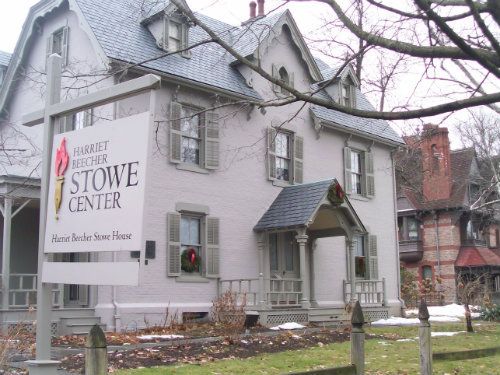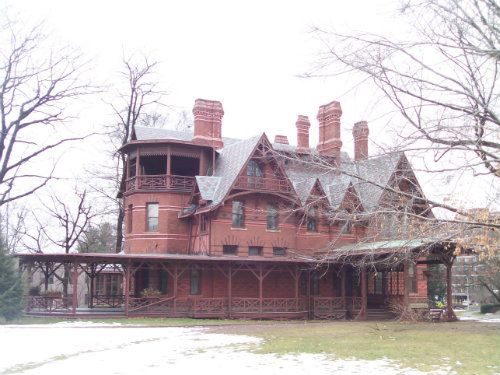Hartford Neighbors: Harriet Beecher Stowe and Mark Twain
In the posh 19th century neighborhood of Nook Farm in what was then the most affluent town in eastern United States, Hartford, Connecticut, both Harriet Beecher Stowe and Mark Twain built their dream homes – literally next door to each other. The two houses have been restored and serve as magical museums of their literary times. Each house offers frequent tours, but on weekends it is possible to enjoy a 90-minute joint tour of the beautiful homes.
By hearing the stories of what went on in these rooms we visit, it is possible to get an intimate picture of the lives of these icons of American literature. It provides a context for understanding the changing ideas of race and gender in pre- and post-civil war America.
Harriet Beecher Stowe made a good deal of money, not only from her mega-hit Uncle Tom’s Cabin, but also from her 29 other books. She was raised in a well-known and highly respected – if poor – family of 11 children. Her father Lyman Beecher was a popular progressive minister who believed in educating his daughters with the aim of ensuring that they would have the tools to improve the world. His sons all became preachers, the most famous of whom was her brother the anti-slavery preacher Henry Ward Beecher.
Lyman Beecher moved the family to Ohio where Stowe met and married her husband Calvin Stowe, a theology professor, and had six of her seven children. Cincinnati was the western frontier of the US and just across the river from the slave state of Kentucky. It was there that Harriet Beecher Stowe saw slavery, met fugitives, and learned of their hardships. The death of her son from typhoid at 18 months gave her empathy, she felt, with women slaves separated from their children.
Uncle Tom’s Cabin changed the entire discourse on American slavery both in the States and in Europe. Begun as a few episodic newspaper chapters, it ended up running for 42 weeks before being collected into a double volume. The only book that beat it in sales was the Bible. In Great Britain alone it sold 1.5 million copies the first year and was then translated into 60 languages. When Stowe later visited the UK, she was greeted not only as a celebrity, but also received an anti-slavery petition of 500,000 hand-signed women’s signatures filling 26 bound volumes, one of which is on display at the Museum’s Center, to present to Washington.
With her own income, she built this comfortable Victorian cottage of 12 rooms in 1871 with modern plumbing and heating. There were no closets for these were taxed as additional rooms, but she included many innovations for health and safety – including a new-fangled closed oven, which prevented the prevalent problem of long skirts being set alight. She remained there until she died in 1896, running both the house and her writing career with the help of her twin daughters – who shared a room with twin beds. They had made the choice to stay single in order to enjoy the greater freedom as mother’s daughters than as men’s wives – with no rights to property, independent travel, or even decisions about one’s children.
Stowe became one of the country’s first snowbirds, moving each winter with her daughters, her furniture, and her pets to Jacksonville, Florida, a 10-day trip. She always returned to her house in Hartford where she was so productive. One oddity about the house: there was not a single corner dedicated to her writing in the whole building, while her husband had a large comfortable study of his own where he managed to produce one book. Her 30 she wrote wherever she found a seat as she raised her seven children with no nanny. Apparently Harriet and Calvin got along so well that contrary to the habits of that period, they shared a bed their whole lives.
One famous story was her meeting with Abraham Lincoln who at 6’4” towered over her 4’11”. As he looked down at her in 1862, he said, “So you’re the little lady who wrote the book that started this Great War.”
Samuel Clemens – known by his pen name Mark Twain – built his dream home just yards away and lived there with his wife Olivia “Livy” Langdon for his 17 happiest years from 1874 – 1891. A generation younger than Stowe, Clemens built the grander edifice largely with his wife’s fortune. A lousy businessman and a poor money manager, he outspent their income and when they left this beloved home, it was because of near financial ruin. It is 11,500 square feet, 25 rooms, and all the lavish downstairs public rooms are in the style of one country or another – from Turkey to India to Moorish Spain.
Like Stowe, he did not come from a lot of money. He was born in the relatively new state of Missouri‚ the sixth of seven children. His father owned a slave and his uncle owned a number of them. His father died when he was 11 and Sam worked as a printer’s apprentice, a river boat pilot, and then traveled as a newspaper reporter. Livy was a decade his junior, but her parents were Abolitionists in Elmira, NY, and had a strong impact on his own thinking. He and Livy had four children, but their only son died of diphtheria at less than two years of age. They seem to have had a lot of fun with their daughters. Susy, the eldest, became his copyeditor. The Clemens paid Clara, the naughty middle sister, three cents a day not to bother her sisters.
On the third floor of the house, Clemens built a man-cave with a billiard table, his writing desk and table, three porches, and even a bedroom for when he was up too late with his chums or his pen. There too he smoked his 20-40 daily cigars and pipes, although he did promise Livy never to smoke more than one cigar at a time. He was particularly close to his butler, a freed slave named George Griffin, who, when the Clemens family left Hartford for a decade of lecturing around Europe in order to stabilize their finances, became a banker. But it is in this dream house that Clemens wrote Tom Sawyer, Huck Finn, Life on the Mississippi, Connecticut Yankee, and more.
Hartford, Connecticut today no longer boasts of being one of the most attractive destinations in the East, but these beautifully restored homes are a treasure for anyone who cares about the social reality of 19th Century America, about the literature that is still part of the national canon, and about the ways in which these writers also expressed themselves in the construction of their residences.
http://www.harrietbeecherstowecenter.org/
http://www.marktwainhouse.org/
Photos by Barry Hock.
Sue Katz, an author, journalist, blogger and rebel, used to be most proud of her martial arts career and her world travel, but now it’s all about her edgy blog Consenting Adult. Sue is a regular contributor to Open Media Boston.



